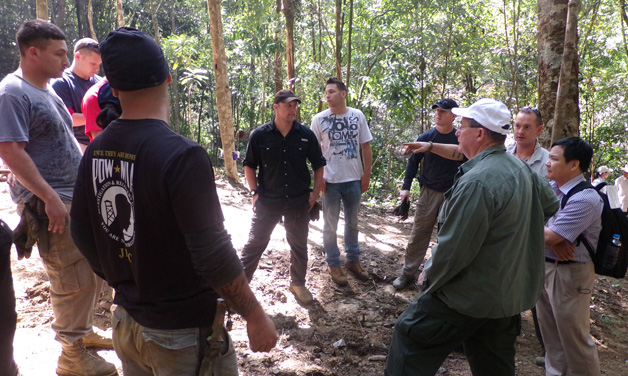
Back to Vietnam, in search of our missing
A 76-year-old man living in the Quang Ngai province of central Vietnam distantly remembers certain details of an A-4 Skyhawk crash that occurred more than 45 years ago. He can point to the location where a U.S. Navy pilot’s parachute got caught in the jungle branches, leaving him suspended over hostile ground. The pilot hung there for some time and then was gone.
The elderly Vietnamese man is unsure what happened next. Searchers have uncovered parachute fragments and some life-support gear. They found shell casings, suggesting there was gunfire at some point. The pilot may have cut himself free, or he may have been shot down. He could have been taken prisoner or lost his life trying to escape.
One thing is certain. He never came home.
The mystery of the Navy pilot is among approximately 83,000 cases the Joint POW/MIA Accounting Command (JPAC) is trying to solve around the world. Nearly 1,700 of those mysteries belong to U.S. military personnel who fought in the Vietnam War.
In June, I fulfilled a pledge to myself and to my fellow veterans of that war to return to Southeast Asia and see what is being done to locate, identify and repatriate the remains of those who disappeared. Like most of my fellow Vietnam War veterans, I passionately believe we must do what it takes to bring our missing and fallen comrades home, no matter the degree of difficulty.
As national commander of The American Legion this year, I have traveled far and wide sharing the message of our great organization’s programs and values. Along the way, I have met with congressional leaders, DoD authorities, VA officials, state lawmakers, governors, troops and, of course, thousands of Legionnaires. We have pushed to improve the adjustment process for newly discharged post-9/11 veterans re-entering civilian life. We have fought to make the GI Bill more valuable. We have called for better treatment for those who come home with post-traumatic stress disorder. We have connected the dots between the Vietnam War era and today’s generation. Many of us who served in Vietnam are especially driven to ensure that our newest wartime veterans are understood, welcomed home and provided support befitting their service. In many cases, Vietnam War veterans did not receive such a welcome. Of course, everyone has a different homecoming story. Everyone, that is, except those who did not make it back.
I wanted to help search for them. About 30 young villagers, a few elders and JPAC personnel worked for nine hours in the tropical heat that day in Quang Ngai, sifting soil and hoping to find a tooth, a bone, a strand of hair – anything that could be taken to the identification laboratory in Hawaii and, through DNA testing, bring that Navy pilot home. It was just one day among many spent looking for the pilot and hundreds of other U.S. MIAs across Southeast Asia. The work is tedious and fraught with obstacles, including extreme weather, insects, leeches, snakes and often-difficult negotiations to obtain access into areas where U.S. military personnel were last seen decades ago. The work depends on the memories of local witnesses, like the 76-year-old man, who are fading fast. Still, new crash sites are located all the time, usually after follow-up research into firsthand witness accounts.
Success in the JPAC mission is measured one positive identification at a time. In 2010, that number was just 67 from the Vietnam War, which may not seem like many. But every one of them matters. Every one deserves our nation’s best effort to get them home and bring honorable closure for their families, and for us.
The day after I visited the Quang Ngai site, JPAC investigators led me to another dig, this one in Thua Thien-Hue province near the former DMZ between South and North Vietnam.
After a two-hour drive along the coast north of Da Nang, we took a twisting mountain road into what is now a Vietnamese national forest. When the road ran out, we hiked uphill through wet foliage to a 100-meter-long excavation site near the top of a mountain, the last known location of two U.S. Air Force pilots whose RF-4 Phantom crashed shortly after takeoff. Following a briefing about the site and the impact of a crash so severe that it left wreckage strewn on two sides of the same mountain, I began sifting dirt through a screen, searching for any tiny fragment of two men who gave their lives for our country. It was an emotional experience.
JPAC operations have been threatened by sequestration, geopolitical tension and the general state of communist East Asian regard for the United States. There’s also been criticism about the pace of progress repatriating our missing. As for sequestration, it’s difficult to furlough civilian employees two days a week to cut costs when those civilian employees are scientists sent on 30-day continuous deployments into the jungles. At the Washington Conference last spring, we learned that previously approved JPAC investigations into North Korea were halted due to U.S.-South Korea joint military exercises. Questions of corruption involving the Cambodian military stopped other efforts. It’s not easy. One thing that should never be questioned, however, is JPAC’s purpose, a point I made last spring when I met with President Obama.
What I saw in Vietnam is to be commended. JPAC personnel, Vietnamese workers and even some of their government officials – who want U.S. help finding some of their own 300,000 MIAs – were well-organized, dedicated and professional. Funding and staffing for the JPAC mission must not dry up. Our commitment to never leave one of our own on the battlefield distinguishes us as a nation. And what we, of the Vietnam War, do for today’s veterans coming home is at least in part done in tribute to those who never got the chance to become civilians again.
- Magazine

